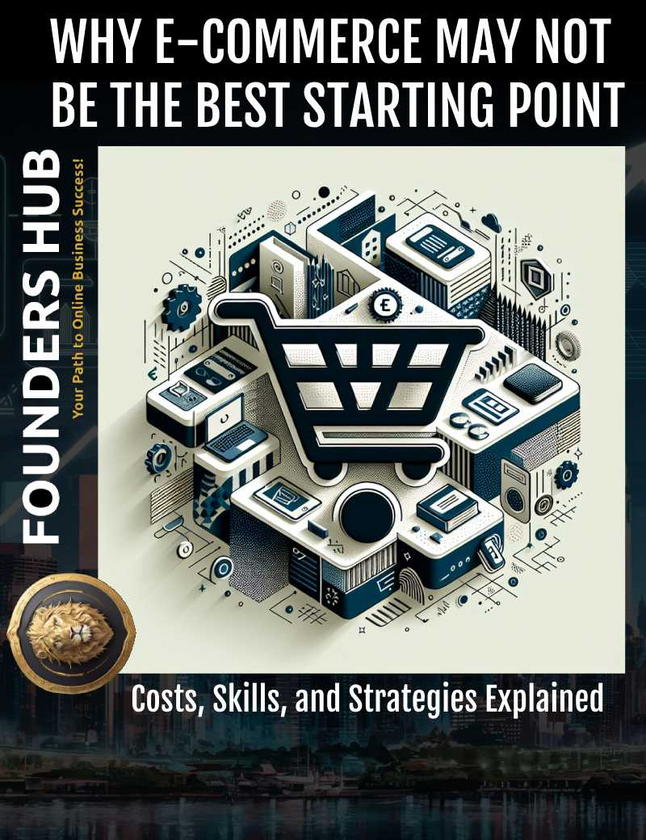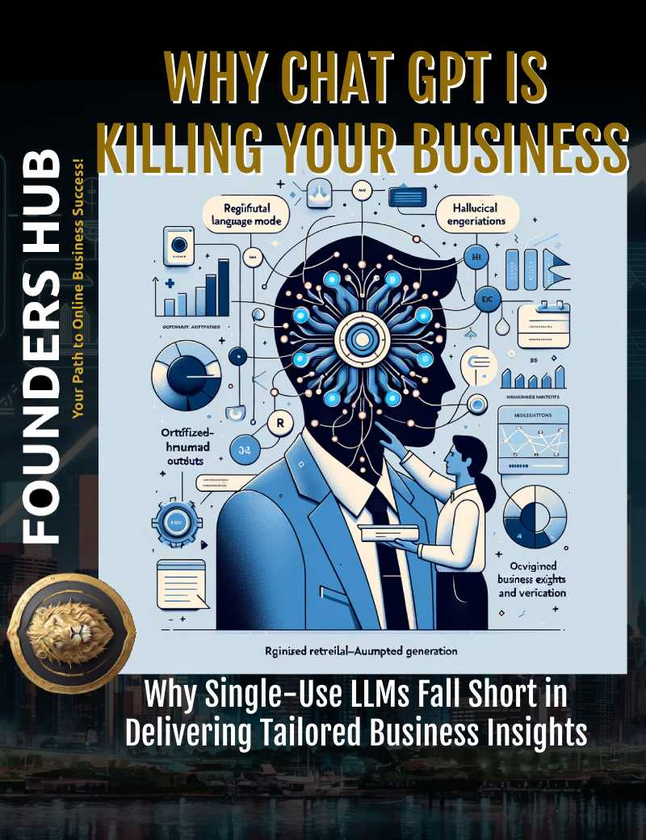In today's digital age, the allure of starting an online business, particularly in the realm of e-commerce, is undeniable. With the global e-commerce market projected to reach a staggering $6.3 trillion by 2024, it's easy to get caught up in the excitement and overlook the complexities and challenges that come with building a successful e-commerce venture.
While the potential rewards are enticing, it's crucial to understand that the e-commerce landscape is highly competitive, with established players and newcomers vying for a share of the market. In 2023 alone, e-commerce accounted for a substantial 15.4% of total retail sales, indicating a crowded and saturated market.
Key Takeaway: Before diving headfirst into the world of e-commerce, it's essential to carefully evaluate the costs, skills, and strategies required to stand out and achieve profitability in this highly competitive space.
Become a supporter to access our exclusive members only content
The Competitive E-commerce Landscape
High Competition
The e-commerce industry experienced a remarkable 50% growth from 2019 to 2021, fueled by the global shift towards online shopping. While this growth presents opportunities, it also intensifies competition, making it increasingly challenging for new entrants to carve out a niche and establish a foothold in the market.
To succeed in this saturated landscape, businesses must differentiate themselves through unique product offerings, exceptional customer service, and effective marketing strategies. Failure to stand out can result in being overshadowed by larger, more established players with deeper pockets and broader reach.
Niche Selection
One of the most critical factors in building a successful e-commerce business is selecting the right niche. A well-defined niche not only helps you target a specific audience but also reduces competition and increases the likelihood of standing out in the crowded e-commerce space.
Conducting thorough market research and niche selection is essential. Tools like Google Trends, keyword research platforms, and industry reports can provide valuable insights into market demand, competition levels, and potential profitability. Neglecting this crucial step can lead to entering an oversaturated or low-demand niche, hindering your chances of success from the outset.
Case studies of successful niche e-commerce businesses, such as Beardbrand (men's grooming products) and Chubbies (men's shorts), highlight the importance of identifying and capitalizing on underserved or emerging markets. By catering to specific needs and interests, these businesses have carved out a loyal customer base and achieved remarkable growth.
Marketing and Promotion Strategies
Importance of Effective Marketing
In the highly competitive e-commerce landscape, effective marketing is not just a luxury; it's a necessity. Without a well-executed marketing strategy, even the most exceptional products or services can go unnoticed, resulting in stagnant growth and potential failure.
To stand out in the crowded online marketplace, businesses must leverage a combination of digital marketing channels, including social media, search engine optimization (SEO), pay-per-click (PPC) advertising, and email marketing. Each of these channels requires specific skills, strategies, and ongoing effort to yield positive results.
Social Media Marketing
Social media platforms like Instagram, Facebook, and TikTok have become powerful tools for businesses to connect with their target audiences, build brand awareness, and drive sales. Successful social media marketing campaigns leverage engaging content, influencer collaborations, and targeted advertising to reach potential customers where they spend a significant portion of their time.
Case studies of businesses like Gymshark and Fashion Nova highlight the power of social media in driving growth and building loyal communities. By consistently creating visually appealing content and leveraging influencer partnerships, these brands have cultivated a strong online presence and cultivated a dedicated following.
Paid Advertising
While organic reach on social media and search engines is valuable, paid advertising platforms like Google Ads and Facebook Ads offer businesses the opportunity to target specific demographics, interests, and behaviors with precision. However, effective paid advertising requires a deep understanding of audience targeting, ad copywriting, and ongoing optimization to ensure a positive return on investment (ROI).
The cost implications of paid advertising can be significant, with businesses often spending thousands or even millions of dollars on campaigns. Careful budgeting and continuous monitoring of performance metrics are crucial to ensure that advertising expenses align with the desired ROI.
Influencer Marketing
In the age of social media, influencer marketing has emerged as a powerful tool for businesses to reach highly engaged and targeted audiences. By partnering with influencers who align with their brand values and resonate with their target demographic, businesses can leverage the trust and influence these individuals hold over their followers.
Successful influencer marketing campaigns require careful vetting of potential partners, negotiating fair compensation, and developing creative collaborations that authentically promote products or services. Examples of successful influencer partnerships include Gymshark's collaborations with fitness influencers and Revolve's partnerships with fashion and lifestyle influencers.
Product Sourcing and Supply Chain Management
Different Sourcing Models
Choosing the right product sourcing model is crucial for the success of an e-commerce business. Each model comes with its own set of advantages and challenges, and selecting the appropriate approach can significantly impact profitability and scalability.
Dropshipping: This model involves partnering with a third-party supplier who handles the inventory and shipping processes. While dropshipping requires minimal initial investment, it often comes with higher competition, lower profit margins, and limited control over product quality and supply chain management.
Inventory Models: In this approach, businesses purchase and store their own inventory, allowing for greater control over product quality, branding, and customer experience. However, this model requires a higher initial investment and carries the risk of overstocking or understocking.
Wholesale Suppliers vs. Manufacturing on Demand: Sourcing products from wholesale suppliers can provide access to a wider range of products and potentially lower costs, but it may limit customization options. Alternatively, manufacturing products on demand allows for greater customization and control but often comes with higher costs and longer lead times.
Managing Inventory and Supply Chain
Effective inventory management and supply chain optimization are critical components of a successful e-commerce business. Best practices include implementing just-in-time inventory strategies, maintaining safety stock levels, and adhering to the first-in, first-out (FIFO) principle to ensure product freshness and minimize waste.
Additionally, leveraging technologies such as Enterprise Resource Planning (ERP) systems and Inventory Management Software can streamline processes, provide real-time visibility into stock levels, and facilitate data-driven decision-making.
Initial Investment and Costs
Starting an e-commerce business can require a significant initial investment, and it's essential to understand and plan for the various costs involved.
Breakdown of Initial Costs
Website Development: Building a professional and user-friendly e-commerce website is crucial for success. Costs can range from a few hundred dollars for pre-built platforms like Shopify or WooCommerce to thousands of dollars for custom website development and ongoing maintenance.
Inventory Costs: Depending on the sourcing model chosen, businesses may need to allocate funds for initial inventory purchases, warehousing, and shipping costs.
Marketing Expenses: Effective marketing is essential for driving traffic and sales, and businesses should budget for digital marketing campaigns, influencer partnerships, and other promotional activities.
Tips for Minimizing Investment
While the initial investment can be substantial, there are strategies to minimize costs and mitigate risks. Adopting a lean startup methodology and developing a Minimum Viable Product (MVP) can help businesses test their ideas and validate demand before committing significant resources.
Additionally, leveraging free or low-cost marketing tools, such as organic social media growth and email marketing, can help businesses build an initial customer base and generate revenue before investing in more expensive marketing channels.
Skills Required to Run a Profitable E-commerce Business
Running a successful e-commerce business requires a diverse set of skills spanning technical, operational, and financial domains.
Technical Skills
Website Development: A solid understanding of e-commerce platforms like Shopify or WooCommerce is essential for building and maintaining a user-friendly online store.
SEO and Digital Marketing: Knowledge of search engine algorithms, keyword research, and content marketing strategies is crucial for driving organic traffic and maximizing online visibility.
Operational Skills
Supply Chain Management: Effective inventory control, logistics coordination, and supplier management are critical for ensuring smooth operations and meeting customer demand.
Customer Service: Providing exceptional customer service, including handling queries, managing returns, and maintaining high levels of satisfaction, is essential for building brand loyalty and driving repeat business.
Financial Management
Bookkeeping: Accurate tracking of sales, expenses, and profits is essential for making informed business decisions and maintaining financial health.
Budgeting: Efficient allocation of resources and careful budgeting are crucial for maximizing return on investment (ROI) and ensuring long-term profitability.
Ongoing Effort and Continuous Improvement
Building a successful e-commerce business is not a one-time endeavor; it requires ongoing effort and a commitment to continuous improvement.
Adapting to Trends
The e-commerce landscape is constantly evolving, with new technologies, consumer behaviors, and industry trends emerging regularly. Staying up-to-date with developments in areas such as artificial intelligence (AI), machine learning (ML), and consumer behavior shifts is essential for maintaining a competitive edge.
Businesses must be prepared to regularly update their product lines, marketing strategies, and operational processes to align with these trends and meet the ever-changing demands of their target audience.
Data-Driven Decision Making
In the digital age, data is a powerful tool for driving business decisions and optimizing performance. Leveraging analytics tools like Google Analytics and monitoring key e-commerce performance metrics can provide valuable insights into customer behavior, marketing campaign effectiveness, and areas for improvement.
Successful e-commerce businesses embrace a data-driven approach, iterating on their marketing campaigns, product offerings, and operational strategies based on data-driven insights to continuously enhance their performance and profitability.
Conclusion
While the e-commerce industry presents exciting opportunities for aspiring entrepreneurs, it's crucial to recognize that building a successful online business in this space is no easy feat. The competitive landscape, the need for effective marketing strategies, the complexities of product sourcing and supply chain management, and the substantial initial investment required all contribute to the challenges faced by new entrants.
However, with careful planning, strategic execution, and a commitment to continuous improvement, it is possible to navigate these challenges and achieve profitability in the e-commerce space. By conducting thorough market research, selecting a profitable niche, implementing effective marketing strategies, optimizing product sourcing and supply chain management, and acquiring the necessary skills, entrepreneurs can increase their chances of success in this dynamic and ever-evolving industry.
Ultimately, while e-commerce may not be the best starting point for every aspiring online business owner, those who are willing to embrace the challenges and invest the time, effort, and resources required can reap the rewards of building a thriving and profitable e-commerce venture.
Become a supporter to access our exclusive members only content



















